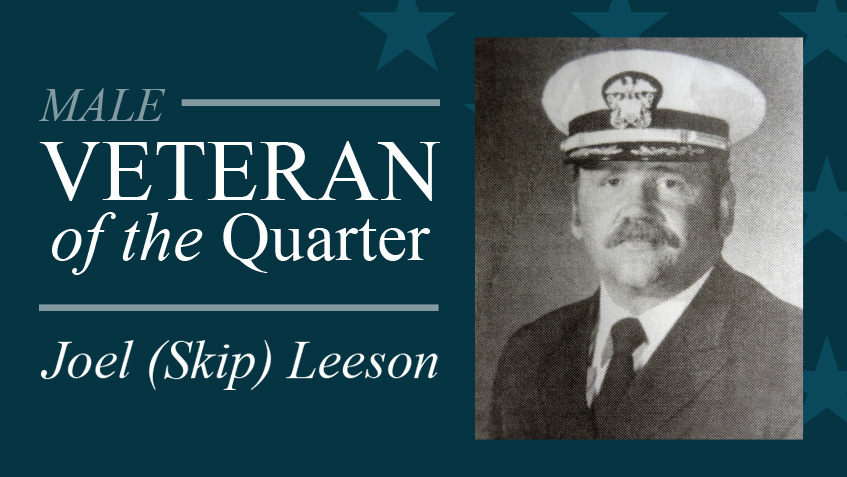This article features Commander Joel (Skip) Leeson of th U.S. Navy
Joel (Skip) Leeson, of Middletown, DE, was living in Woodbridge, New Jersey when he was accepted into Rutgers University.
Following college, he joined the Navy. He went to Officer Candidate School in 1967. At 22 years of age, he was commissioned as an Ensign in the U.S. Navy and spent 2 ½ years on active duty. When he came home, Skip became a member of the U.S. Navy Reserve, drilling on weekends, and working for Mine Forces.
He shared that back then, “Officer Candidate School was not the most pleasant. They tended to cram as much as possible into four months of training.” He graduated as Color Company Commander and received six awards. After that, he went to Anti-Submarine Warfare School in Key West, Florida before being assigned to a destroyer, the USS Buck DD-761, off the coast of Vietnam. Skip said his biggest concern was that they were the first ship in the Sea of Japan when the USS Pueblo was taken by the North Koreans. They were the designated ship to go into Wonsan Harbor and get it back if the order was given. Thankfully, the order was not given. He became an ASW (Anti-Sub Warfare) Officer and Gunnery Plot Officer. His most important job was standing bridge watches as the Officer of the Deck and running the ship. As Gunnery Plot Officer he was responsible for shore bombardments.
At that time, Vietnam was divided into five sections north to south. 1 Corps was the DMZ (demilitarized zone). 5 Corps was the Mekong Delta. The Ship worked mostly off 3 Corps, at the mouth of the Saigon River, where his Destroyer was assigned to help the Australians. We even parked in the mouth of the Saigon River to help the River Patrols. We were also called to protect USS New Jersey BB-62 off 1 Corps on the DMZ.
Our ship was never shot at, even though it went into harm’s way a few times. He managed to stay in touch with family by mail. He did get some treats in return mail, but the “mail was always late.” There are no breaks at sea; he did two bridge watches a day and refueled at sea every three days, so there was lots of paperwork to do.
A typical day was reveille at 6 am. Breakfast 6:30 to 7:30. Commence ship’s work 8-11, Lunch 11 to 12:30. Continue ship’s work until 4:30. Dinner 6-7 pm. Taps at 10. In addition, depending on the number of watch sections, standing Bridge watches 2 or 3 times a day. Then doing paperwork, gun shots, flying DASH (drone antisubmarine helicopter, remote controlled), Underway replenishment every 2 to 3 days (mostly refueling). Skip has stayed in touch with many of his officer shipmates; one lives in Australia, one in Guam, and some others are in the United States. After his discharge from duty in 1969, he joined the VFW. He also stayed in the reserves and retired as a Commander.
In 1982 he was chosen to command the Naval Reserve Unit attached to the USS New Jersey. It was his second Ship Reserve crew Command, the first being USS Arkansas CGN-41. Both Arkansas and New Jersey were start-up units. The USS New Jersey was stationed off the coast of Beirut in 1983-84 and was not given a relief. As Commanding Officer and as part of the reserve unit, the Chief of Naval Reserve was contacted and an airlift to the ship to relieve part of the crew was obtained with the help of USS New Jersey CO.
It was so successful, five additional flights were scheduled, and reservists from all over the country volunteered. Reservists, during this action, relieved over half the crew (700) in increments, so they were able to go home on leave. It was the largest peacetime crew relief in the history of the Navy.Where do you go from here? To US Forces Caribbean reserve unit drilling in Wilkes Barre, PA. Having to do simulated confrontations in the Gulf of Mexico. That then became US Forces Atlantic and went to Norfolk for some drill weekends to help out Desert Shield.
I cannot express how much I miss the Navy and comradeship with the other services. I still work on what is now the Battleship New Jersey Museum in Camden, NJ. I help mostly with tours and Overnight Encampments where we stay overnight with families and scouts. Makes me feel like I still am accomplishing something.
Read more articles from VOM Magazine here: https://www.veteransoutreachministries.org/vom-magazine/





